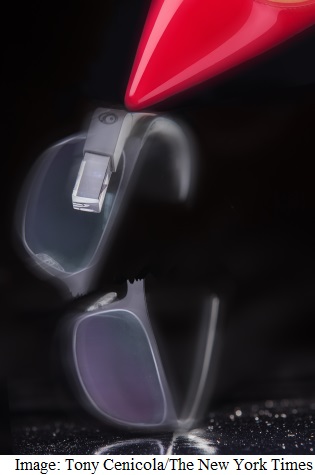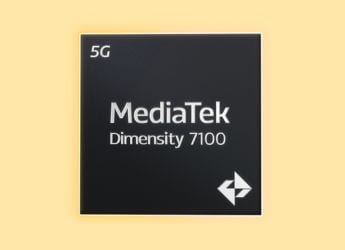- Home
- Wearables
- Wearables Features
- Broken Glass
Broken Glass

Before we begin, this is the part in the tale where I should probably explain what Google Glass is. Except, I don't have to. Google Glass didn't just trickle out into the world. Instead, it exploded with the kind of fuss and pageantry usually reserved for an Apple iSomething.
From its unveiling in 2012, it was considered the Gadget, yearned after by everyone from nerds and chief executives, to chefs and fashionistas. It was the must-have toy that was going to set the gold standard for a new class of wearable computers.
Time Magazine named it one of the "Best Inventions of the Year." It got its own 12-page spread in Vogue magazine. "The Simpsons" devoted a show to Google Glass, though Homer called them "Oogle Goggles." Glass did the rounds on the morning and evening shows, and it was the subject of numerous comedy skits including on "Saturday Night Live," "The Colbert Report" and countless YouTube videos. Presidents from around the globe tested them. Prince Charles wore a pair. As did Oprah, Beyoncé, Jennifer Lawrence and Bill Murray.
There was also the moment at New York Fashion Week in 2012, when Diane von Furstenberg sported a red pair, and sent her models down the runway with different-colored ones. Later, in a slickly produced video, von Furstenberg (wearing a new pair produced by DVF | Made for Glass) told Isabelle Olsson, a Google designer, "We revealed Google Glass to the world."
And in another sign of its cultural import, The New Yorker ran a 5,000-word feature on what it was like to wear the novel device, written by a so-called Google Glass Explorer invited by Google to test the product. Here, Gary Shteyngart comically recounts an impromptu product demonstration he gave on the 6 train. "Are those them?" one businessman asked him. "That is so dope," a college student says. "You're lucky."
But perhaps the biggest splash took place last week when, out of nowhere, Google announced that Glass, as we know it, was going away.
Poof! Gone. All that fanfare for nothing.
According to a half-dozen current and former Google employees who were involved with Google Glass, this wasn't how the story was supposed to end. But the introduction of Glass - and the hoopla that accompanied it - was also not how the story was supposed to begin, either.
To understand what went wrong, we need to travel back a few years to Mountain View, California, deep inside the sleek offices of Google. There, amid the colorful campus logos and swaying sycamore trees, the company's founders and a handful of trusted executives came up with a list of 100 futuristic ideas.
These included indoor GPS and a project called the Google Brain. But the excitement was reserved for a new genre of wearable computers that could be attached to skin or, possibly, worn like glasses.
By late 2009, Eric Schmidt, then Google's chief executive, approached Sebastian Thrun, a genius jack-of-many-trades researcher at Stanford University, and recruited him to build out these ideas. Thrun, instructed to come up with a cool name, temporarily called the lab "Google X," hoping to choose something better later.
According to several Google staff members who worked on the early stages of the X project (all of whom would discuss the project only with the promise of anonymity, either because they continued to work for the company or because they still had business relationships with it), the lab soon found a covert home on the Google Campus, taking over the second floor of a nondescript building at 1489 Charleston Ave. There, the lab's first project was born: a sort of virtual-reality-type thing that would later become known as Google Glass.
Thrun recruited a slew of rock-star scientists and researchers to work on Glass, including Astro Teller and Babak Parviz, both at the forefront of wearable computing, and Olsson, the designer. Before long, Sergey Brin, Google's co-founder, joined to help run X.
It's important to note two things about Brin here. At the time, he was married to Anne Wojcicki, a genetic-testing entrepreneur and the mother of their two children. Second, he had a reputation at Google for having what has been widely quoted as "project attention deficit disorder," becoming obsessed with one project and then sauntering off to the next.
(Google declined to comment for this article or to make Brin and other current executives available.)
With Brin and Thrun at the helm, Google X and the glasses project managed to stay under wraps for more than a year. "Everyday Google employees would walk by and have no idea what was going on inside X," one Google X employee said.
That was, until 2011 when my colleague Claire Cain Miller and I broke the news about the secret Google X Lab, which detailed some of the projects in the works at X.
At the time, unknown to anyone outside X, an impassioned split was forming between X engineers about the most basic functions of Google Glass. One faction argued that it should be worn all day, like a "fashionable device," while others thought it should be worn only for specific utilitarian functions. Still, nearly everyone at X was in agreement that the current prototype was just that: a prototype, with major kinks to be worked out.
There was one notable dissenter. Brin knew Google Glass wasn't a finished product and that it needed work, but he wanted that to take place in public, not in a top-secret lab. Brin argued that X should release Glass to consumers and use their feedback to iterate and improve the design.
To reinforce that Glass was a work in progress, Google decided not to sell the first version in retail stores, but instead limit it to Glass Explorers, a select group of geeks and journalists who paid $1,500 for the privilege of being an early adopter.
The strategy backfired. The exclusivity added to the intense interest, with media outlets clamoring for their own piece of the story. As public excitement detonated, Google not only fanned the flames, but doused them with jet fuel.
"The team within Google X knew the product wasn't even close to ready for prime time," a former Google employee said. The Google marketing team and Brin had other plans.
At a Google developers conference in June 2012, for example, Glass-wearing sky divers landed on top of the auditorium, raced across the roof on bikes and into the conference hall to thunderous applause. (I was there and it was unlike any demo I had ever seen.) Brin seemed to revel in the attention and was labeled a real-life Tony Stark, from the Iron Man comics. Later that year, Brin would sit front row at von Furstenberg's show, proudly accessorized with a pair of Glass.
This wasn't how Glass was supposed to be introduced. This wasn't the quiet experiment that Google X engineers had hoped for as they tinkered away. It was like watching someone whisper a secret with a bullhorn.
But sky divers and models can only do so much, and the shine started to wear off. Tech reviewers who finally got their hands on Glass described it as "the worst product of all time," aptly noting that it had abysmal battery life, and that it was "a product plagued by bugs." Privacy concerns were raised, with people afraid of being recorded during private moments, like at the urinal, as I experienced at another Google conference where I was surrounded by Glass wearers. It was also banned from bars, movie theaters, Las Vegas casinos and other places that did not want customers surreptitiously recording.
Glass went from being coveted to becoming a punch line. There was a Tumblr site called White Men Wearing Google Glass.
Then, in early 2014, a tabloid-worthy scandal hit the Google X labs. Amid the 3D printers and microchips, a love affair had developed between Brin and Amanda Rosenberg, a marketing manager on Google Glass who had helped organize the Diane von Furstenberg fashion show. Brin was leaving his wife for Rosenberg, who was in turn leaving her boyfriend, who also worked at Google. In an even stranger twist reported in Vanity Fair, it turned out Brin's wife had been friends with Rosenberg.
From there, Google Glass seemed to wither away. Early X employees left, including Parviz, who decamped to Amazon. Brin, who was dealing with the fallout of his affair at Google, stopped wearing Glass in public, too.
And that's how we arrive at last month, when Google abruptly announced that it was shuttering its Glass Explorer program. It has largely been reported as the death knell for Glass. But maybe not.
In its new life, Glass is overseen by Ivy Ross, a jewelry designer who runs Google's smart-eyewear division, and Tony Fadell, a former Apple product executive and the creator of Nest. Several people with knowledge of Fadell's plans for Glass said he was going to redesign the product from scratch and would not release it until it was complete.
"There will be no public experimentation," one adviser to Fadell said. "Tony is a product guy and he's not going to release something until it's perfect."
As for von Furstenberg, she has no regrets. In an interview Tuesday, she said that Google Glass was nothing short of revolutionary. "This was the first time that people talked about wearable technology," she said. "Technology moves on faster and faster, and Google Glass will always be part of history."
© 2015 New York Times News Service
Catch the latest from the Consumer Electronics Show on Gadgets 360, at our CES 2026 hub.
Related Stories
- Samsung Galaxy Unpacked 2025
- ChatGPT
- Redmi Note 14 Pro+
- iPhone 16
- Apple Vision Pro
- Oneplus 12
- OnePlus Nord CE 3 Lite 5G
- iPhone 13
- Xiaomi 14 Pro
- Oppo Find N3
- Tecno Spark Go (2023)
- Realme V30
- Best Phones Under 25000
- Samsung Galaxy S24 Series
- Cryptocurrency
- iQoo 12
- Samsung Galaxy S24 Ultra
- Giottus
- Samsung Galaxy Z Flip 5
- Apple 'Scary Fast'
- Housefull 5
- GoPro Hero 12 Black Review
- Invincible Season 2
- JioGlass
- HD Ready TV
- Laptop Under 50000
- Smartwatch Under 10000
- Latest Mobile Phones
- Compare Phones
- OPPO Reno 15 Pro Max
- Honor Win RT
- Honor Win
- Xiaomi 17 Ultra Leica Edition
- Xiaomi 17 Ultra
- Huawei Nova 15
- Huawei Nova 15 Pro
- Huawei Nova 15 Ultra
- Asus ProArt P16
- MacBook Pro 14-inch (M5, 2025)
- OPPO Pad Air 5
- Huawei MatePad 11.5 (2026)
- Xiaomi Watch 5
- Huawei Watch 10th Anniversary Edition
- Acerpure Nitro Z Series 100-inch QLED TV
- Samsung 43 Inch LED Ultra HD (4K) Smart TV (UA43UE81AFULXL)
- Asus ROG Ally
- Nintendo Switch Lite
- Haier 1.6 Ton 5 Star Inverter Split AC (HSU19G-MZAID5BN-INV)
- Haier 1.6 Ton 5 Star Inverter Split AC (HSU19G-MZAIM5BN-INV)
















